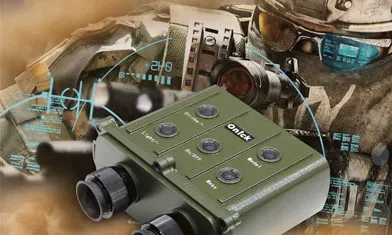How Much Do You Really Know About Individual Night Vision Goggles?
Individual night vision devices are crucial equipment for individual soldiers to observe, aim, and maneuver in low-light or nighttime environments. Their technical principles, classifications, performance indicators, and application scenarios all hold profound professional implications.
Individual night vision devices are night vision equipment used by individual soldiers. In addition to meeting the needs of nighttime observation and detection, they have recently added many surprising features. Before exploring the functions of new individual night vision devices, let's take a look at their various types.
The most common individual night vision devices are probably Generation 2+ or 3 devices with low-light tubes. These devices are categorized by their appearance as monocular, binocular, or binocular. Because they are designed for individual use and require hands-free operation, these three types of night vision devices are generally head-mounted or helmet-mounted. As shown in the figure below,
To truly understand them, we need to consider the following core dimensions:
1. Core Technical Principle: How do we "see" in the dark?
The core of individual night vision devices is to convert weak light signals (or invisible light) into visible light images. Based on different technical approaches, they are divided into two categories:
Low-light-level night vision technology: Utilizing weak natural light (such as moonlight, starlight, and atmospheric glow) in the night environment, the image intensifier (a core component) amplifies the light signal by tens to hundreds of thousands of times. The photocathode in the image intensifier converts photons into electrons. These electrons are accelerated by an electric field and then strike a fluorescent screen, where they are reconverted into a visible light image, achieving "low-light-level brightness."
Infrared night vision technology: It is divided into active and passive types.
Active night vision devices use a built-in infrared light source (such as an infrared LED) to illuminate the target with infrared light, which is invisible to the human eye. A receiver then receives the reflected light to create an image (similar to an "infrared flashlight combined with a camera," but more easily exposed).
Passive night vision devices (thermal imaging): Do not require a light source. Instead, they detect infrared radiation emitted by the target itself (all objects with a temperature above absolute zero radiate infrared radiation). This is converted into an electrical signal by an infrared detector, which then generates a thermal image (temperature differences are displayed as different colors/grayscales). II. Main Classification: By Technology and Application
1. By Technology Type
Low-Light-Level Night Vision Devices (GEN 0 to GEN 3+):
Classified by image intensifier technology generation, higher generations have higher sensitivity, resolution, and lifespan:
GEN 0: Early product, requires an auxiliary infrared light source, has low resolution (approximately 25-40 line pairs/mm), and has been phased out;
GEN 1: Does not require an infrared light source, can operate using starlight, has a resolution of 50-70 line pairs/mm, and is widely used in civilian applications;
GEN 2: Uses a microchannel plate (MCP) to enhance electronic signals, has a resolution of 70-100 line pairs/mm, and a lifespan of over 10,000 hours, and is the mainstream military device;
GEN 3+: Based on GEN 2, uses an optimized photocathode (e.g., gallium arsenide), has a resolution exceeding 100 line pairs/mm, and can operate in "ultra-dark" environments (0.001 lux). It is standard equipment on systems such as the US Army's Land Warrior. Thermal imaging night vision devices:
Based on detector type, they are categorized as "cooled" (highly sensitive, suitable for long-range detection, such as military long-range reconnaissance) and "uncooled" (small size, low power consumption, suitable for individual portability, such as patrolling and close-quarters combat). Their advantages are complete insensitivity to light, penetrating smoke, fog, and rain, and independent of ambient light, resulting in far superior concealment compared to active infrared devices.
2. By Application
Handheld observation devices, such as monocular/binocular handheld night vision devices, are used for night patrols and reconnaissance, emphasizing portability and field of view.
Head-mounted devices: Integrated with a helmet, hands-free, suitable for individual maneuvering and shooting. For example, binocular night vision devices can be quickly switched with a helmet mount.
Weapon-aiming devices: Integrated with a firearm, used for nighttime aiming and shooting, requiring alignment with the firearm's ballistics. Some also offer observation capabilities (such as infrared thermal imaging scopes, which can display a thermal image while aiming).
III. Key Performance Indicators: Determine Combat Capability
Resolution: Measured in "line pairs/mm" (low-light-level) or "pixels" (thermal imaging), it directly impacts image clarity. For example, a GEN 3 low-light-level night vision device has a resolution of approximately 120 line pairs/mm, and a 640×512 pixel thermal imager can clearly identify a person at a distance of 500 meters.
Sensitivity: Low-light-level night vision devices are measured in "minimum operating illumination" (e.g., 0.001 lux, equivalent to a moonless night); thermal imagers are measured in "NETD" (noise equivalent temperature difference). The lower the value (e.g., < 50mK), the better it can distinguish subtle temperature differences (such as the temperature difference between the human body and the surrounding environment).
Field of view: This determines the observation range. Handheld models typically have a field of view of 20°-40°. A smaller field of view will affect search efficiency, while a larger field of view may reduce edge resolution.
Battery life and weight: Individual equipment must be lightweight (e.g., the AN/PVS-14 is approximately 380 grams) and provide at least 8-12 hours of continuous combat (typically using a CR123A lithium battery).
Environmental adaptability: Waterproof (e.g., IP67), shockproof (withstands firearm recoil), and low-temperature operation (-40°C to 50°C) are basic requirements for military models.
IV. Practical Value and Limitations: More Than Just "Seeing"
Advantages:
Nighttime Initiative: Enables individual soldiers to maintain mobility, reconnaissance, and firing capabilities in darkness, breaking the traditional notion that "nighttime is equivalent to a pause in the battlefield";
Complex Environment Penetration: Thermal imaging can penetrate smoke, dust, rain, and fog, while low-light-level night vision devices can detect camouflage (such as personnel covered by vegetation) even under starlight;
Concealment: Passive technologies (low-light level and passive infrared) do not emit signals and are difficult for enemy detection (active infrared is easily detected by enemy night vision devices and is being phased out). Limitations:
Low-light-level night vision devices rely on ambient light: They are ineffective in completely dark environments (such as confined caves) and require infrared fill light (which exposes the device).
Thermal imagers are expensive: Uncooled thermal imagers are still more expensive than high-end low-light devices, and image details (such as facial features) are not as clear as in low light.
Interference from bright light: Low-light-level night vision devices may temporarily fail in strong light (such as car lights or explosions). Therefore, they require automatic gain control or bright light protection.
Field of view and depth of field limitations: Night vision devices typically have a narrower field of view than the naked eye and a smaller depth of field. This can easily cause "tunnel vision" when moving quickly, impairing spatial judgment. V. Development Trends
Development Trends:
Multispectral Fusion: Fusion of low-light, infrared, thermal, and visible light images, combining their respective strengths (e.g., thermal imaging's penetration and low-light detail);
Intelligent: Incorporation of AI target recognition (automatic identification of people and vehicles), digital zoom, GPS positioning, and data feedback, integrated into individual soldier information systems;
Lightweight and Low Power: Utilization of new materials (e.g., vanadium oxide uncooled detectors) reduces weight to under 200 grams and increases battery life to 24 hours;
AR Enhancement: Overlaying night vision images with tactical information (e.g., friendly force positions and target distances) improves decision-making efficiency.
The value of individual soldier night vision devices goes beyond simply providing nighttime visibility; it also transcends environmental constraints through technology, reshaping the rules of nighttime combat. From early active infrared to today's multispectral fusion, its development has consistently centered on the core principles of "clearer, more concealed, and more intelligent." In the future, it will be deeply integrated into individual soldier information systems, becoming a key node in battlefield perception.
Individual soldier digital night vision devices and individual soldier thermal night vision devices offer very similar features, such as Beidou GPS positioning, an electronic compass, and Wi-Fi and app-based remote control. These two types of individual soldier night vision devices offer slightly superior functionality compared to the first type of low-light-level image tube thermal imaging devices. Comparing the differences between the three types of individual soldier night vision devices, low-light-level image tube night vision devices focus on clear viewing, individual soldier thermal night vision devices prioritize detection, and individual soldier digital night vision devices offer a full range of functions. There are many more individual soldier night vision devices available. Feel free to leave a comment in the comments section and learn from everyone.





















